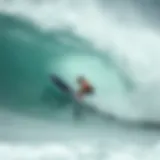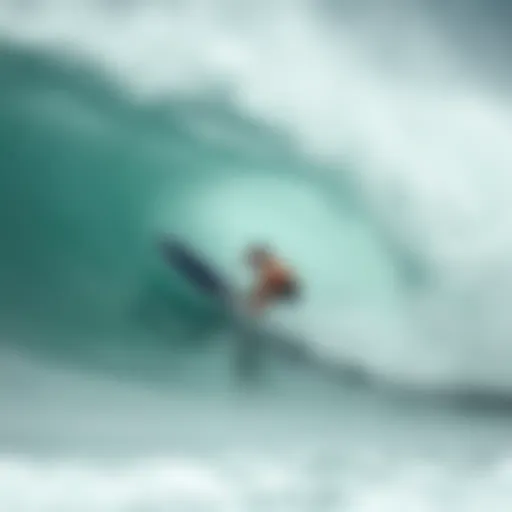Mastering Free Surf Reports: Key Insights for Surfers
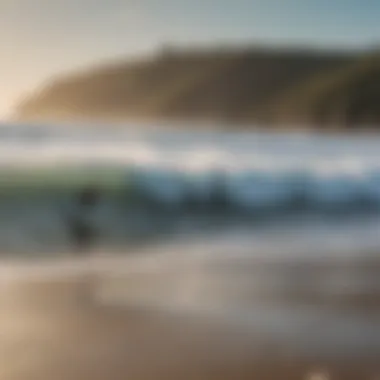

Intro
Surfing is more than just a sport; it's a way of life for many. As waves crash and sun sets, every surfer knows that understanding the ocean's temperament is crucial to a fulfilling day on the board. When it comes to venturing into the vast, unpredictable waters, free surf reports serve as an invaluable compass. These reports not only save time but also bring clarity to what waits beyond the shore. For surfers, from novices to seasoned riders, knowing how to navigate these reports can mean the difference between a perfect day catching waves and a frustrating outing.
The Importance of Free Surf Reports
Free surf reports offer the latest updates about surf conditions, tide schedules, and weather patterns — all vital aspects that can impact a surfer's experience. Without this information, hitting the waves could feel like flying blind.
Many surfers rely on trusted sources to provide these reports, which ultimately help them decide where and when to surf. Moreover, as technology advances, the tools available for weather prediction improve, allowing surfers to keep their finger on the pulse of the ocean more effectively than ever before.
It's critical to interpret these reports with care. Surfing isn't just about catching a wave; it's about understanding the environment in which you're riding. Sometimes, a clear report may not tell the whole story if local conditions are at play. In the upcoming sections, we will discuss the various types of surf reports available and how to make the most of them.
Surf Gear and Equipment
Every surfer knows that having the right gear is as essential as understanding surf reports. The right surfboard or accessories can enhance performance and comfort, making the experience much more enjoyable.
Latest Surfboard Technologies
Advancements in surfboard technology have transformed the way surfers interact with water. Boards made from epoxy resins, for instance, are lighter and more durable than their traditional fiberglass counterparts. You might also see designs catering to specific styles — from minimal boards for small waves to thick, buoyant ones for bigger swells. The introduction of hydrodynamic shapes and custom fins allows surfers to experiment with different riding techniques, improving their overall skill and enjoyment of the sport.
Essential Accessories for Surfers
Besides the surfboard itself, various accessories are game-changers for surfers:
- Wetsuits: Proper insulation aids in staying warm during chilly sessions, ensuring longer and more comfortable surfing outings.
- Leashes: These are crucial for safety as they keep the board attached to the surfer, preventing dangerous situations.
- Rash Guards: Protecting skin from abrasions while providing some sun coverage, these garments are both functional and necessary.
- Wax: A small but mighty component, surfboard wax ensures grip and stability while riding.
Having these essentials not only enhances performance but also elevates the overall experience when navigating the water.
Techniques and Skills
In addition to understanding surf reports and possessing the right gear, developing proficient techniques is paramount. Knowing how to ride the waves efficiently will significantly change your interaction with the ocean.
Wave Riding Strategies
Adopting specific strategies for wave riding can heighten your performance. For instance, mastering the art of paddling techniques can ensure you catch waves more effectively. Timing your take-off and positioning your board at the right angle against the wave are also game-changers. Utilizing a gazing method, where a surfer looks down the line of the wave, can help identify potential sections for maneuvers.
Safety and Surf Etiquette
Safety always comes first. Recognizing the potential hazards of the ocean is fundamental for all skill levels. It's crucial to observe surf etiquette, respecting others in the lineup. This means waiting your turn for the wave and ensuring you don't cut off another surfer. Additionally, understanding how to read currents and tides will minimize risks and enhance the overall surfing experience.
"Knowledge is like a surfboard; the more you have, the better you ride the waves of the ocean."
As we dive deeper into the nuances of surf reports in later sections, these skills, along with accurate information, will ensure that surfing is not only thrilling but also safe.
Understanding Free Surf Reports
Surfing enthusiasts know full well that riding a wave is as much about timing as it is about skill. Understanding free surf reports is crucial for anyone looking to get the most out of their time on the water. They offer insight into the ocean's moods, helping surfers make educated decisions about when and where to surf. The beauty of these reports lies in their accessibility; surfers of all levels can use them without breaking the bank.
Defining Surf Reports
When we talk about surf reports, we’re referring to a collection of data that gives surfers a heads-up about the day's largest factor—wave conditions. Primarily, these reports provide information on wave height, wind direction, tide times, and weather—essentially painting a picture of what's happening out in the ocean. But it’s not just numbers tossed into the air; it’s about the nuances. For instance, two beaches might report the same wave height, but their shape and frequency can still differ. Also, local offshore winds can morph the ride, meaning one beach could be thrilling while another feels like a snooze fest. Surf reports transform vague guesses into educated surfing opportunities.
Importance of Surf Reports for Surfers
Imagine heading out blindly without any knowledge of the surf. A major bummer, right? Surf reports are vital for surfers aiming to enjoy their time to the fullest. Here’s why:
- Safety: Knowing wave heights and tidal conditions can prevent unwary surfers from facing dangerous situations. Reports can indicate when it’s too risky to surf, especially for beginners.
- Optimal Conditions: For those hoping to catch the perfect wave, reports help identify ideal surf conditions. Catching a swell can be a strong motivator, and being in the right spot at the right time can mean the difference between riding the wave of a lifetime or floundering around in flat water.
- Community Insights: Many free surf reports come from locals who know the areas intimately. These reports often carry tips about hidden spots and conditions that aren't obvious to outsiders. Thus, it creates a bridge between the seasoned surfer and someone just starting out.
- Impact on Performance: Understanding conditions aids performance. Better awareness of wave breaks, wind patterns, and tides allows surfers to tweak their techniques accordingly.
“A surfer's day is determined by the ocean’s whispers; getting the right intel can make or break your experience.”
In summary, surfing isn’t as simple as a board and a wave. With the right surf report in hand, surfers minimize uncertainty and set themselves up for success. The following sections will delve into various types of surf reports, their sources, and much more, guiding you to make the most informed choices for your surfing adventures.
Types of Surf Reports
Understanding the various types of surf reports is crucial for any surfer looking to catch the perfect wave. Each type provides unique insights that cater to different aspects of surfing conditions. Knowing how to interpret these reports can significantly enhance your surfing experience, making them essential tools in your arsenal. It's not just about riding waves; it's also about being well-informed to make the most of your time in the water.
Wave Height and Period
Wave height is one of the most crucial factors in surfing, as it directly affects the ride. When you're scouring through a surf report, you'll often see the height measured in feet. A wave height of two feet might feel like a mild adventure for seasoned surfers, while ten-foot waves could be daunting for less experienced riders.
Wave period refers to the time between consecutive waves, typically measured in seconds. A wave with a long period, say about 15 seconds, generally indicates that the swell is traveling a long distance. This often means cleaner, more powerful waves, perfect for those who are willing to take the plunge into bigger surf.


Surf reports will typically provide this information, giving surfers the data they need to gauge if the conditions are suitable for their skill level and style. There’s nothing worse than paddling out only to realize that the conditions aren’t what you anticipated.
Wind Conditions
Wind can make or break a surf session. Look out for onshore and offshore winds in your surf reports. Onshore winds can create choppy surfaces that disrupt wave formation, often leading to less-than-ideal conditions. Conversely, offshore winds smooth the surface and help create well-formed waves that many surfers relish.
Knowing the wind conditions and their direction is crucial, especially when planning your surf outing. A light offshore breeze can do wonders, while strong onshore winds can spoil your day. When analyzing reports, pay attention to the wind speed (measured in knots) as well. Surfers will typically want to surf when the winds are light or moderate, to ensure the best possible experience.
Tide Information
Tides can significantly influence surfing conditions. The relationship between the tide and surf is crucial for finding the right spot to ride. Each surf spot has its own unique tide schedule that can change the dynamics of the waves. Some breaks work better at low tide, while others are prime during high tide.
In a surf report, you'll often find tide times alongside the expected surf conditions. This data allows surfers to schedule their sessions for optimal wave quality. Ignoring the tide can lead to missed opportunities or even dangerous situations, particularly when strong currents are at play. Timing your surf outing with the tides can often make all the difference.
Weather Forecasts
Miscellaneous weather factors should also command your attention. Forecasts indicating rain, storms, or sunshine can play a role in your overall surfing experience. For example, if a storm is brewing, it could stir up the ocean, causing unpredictable conditions that could either create fantastic waves or make for a hazardous environment.
Real-time weather updates often accompany surf reports, detailing expected conditions throughout the day. Storm surfers revel in the thrill of big swells, while others might opt to stay ashore. More than just whimsy, understanding weather patterns enables surfers to approach the ocean with respect and caution, safeguarding their own safety and maximizing fun.
To surf smart, it is best to stay informed, weigh all the conditions, and appreciate the unpredictable nature of the sea.
By mastering the different types of surf reports, surfers can navigate the waters with greater confidence and skill. Armed with this knowledge, they can make better decisions about their surf outings, leading to more enjoyable experiences on the waves.
Key Sources of Free Surf Reports
When it comes to surfing, knowing where to find reliable surf reports can make or break your day out on the water. A good surf report doesn’t just hand over numbers; it captures the very essence of what’s happening at the beach. By tapping into the right sources, surfers can access information that ranges from wave height to wind conditions, all integral in crafting a successful surf strategy. Here, we explore some key sources you can turn to for those crucial surf updates.
National Weather Services
National Weather Services often stand as the backbone of surf reporting. These services use complex technologies and meteorological data to provide accurate forecasts. Here’s why they matter:
- Reliability: National weather agencies, like the National Oceanic and Atmospheric Administration (NOAA), have access to vast amounts of data. This helps ensure the forecasts are both accurate and reliable.
- Comprehensive Coverage: They offer broad coverage that includes not just the surf but also localized conditions, like storms and temperature changes, which might affect your surf day.
- Free Access: Most of the data from these services is available at no cost, affording savvy surfers the ability to plan their outings without breaking the bank.
In short, checking a national weather report can give surfers peace of mind, along with a detailed look at what Mother Nature has in store.
Local Surf Shops and Schools
When you’re searching for that insider information, local surf shops and schools are goldmines. They bring a unique flavor to surf reporting. Here’s what makes them stick out:
- Expert Guidance: The staff are usually seasoned surfers themselves. They understand the local breaks and can tell you where the best waves are and at what time.
- Community Connection: Many local surf shops foster a tight-knit community. News spreads quickly, and you might come across information that isn’t yet reflected in the broader online reports.
- Hands-On Experience: These venues regularly host lessons and events, allowing for firsthand accounts of current conditions, giving you insights from those who've just caught a few waves.
Next time you're about to hit the waves, consider swinging by a local surf shop. You might discover some locals’ tips that make your surf session truly exceptional.
Online Surf Platforms
In this digital age, a myriad of online surf platforms exists that can help you gauge conditions before heading out. Sites like Surfline and Magicseaweed are popular among surfers. Let’s break down why these platforms are pivotal:
- User-Friendly Interfaces: Many of these websites have visual dashboards that present wave height, swell direction, and wind speeds in an interactive way.
- Global Reach: They offer forecasts for popular and lesser-known surf spots alike, allowing surfers to explore new locations without missing a beat.
- Real-Time Updates: Some platforms provide live webcams, verifying conditions at the exact moment you wish to surf.
Utilizing online surf platforms can fundamentally transform your surf planning experience, giving you immediate data when you need it.
Mobile Applications
Smartphones have become our best friends, so why not let them guide you on the waves? Surf forecasting mobile apps are a growing trend among surfers. Here are their notable features:
- Accessibility: Having surf reports at your fingertips means you can check conditions on-the-fly, right before you put your board in the water.
- Location-Specific Alerts: Apps often allow users to set alerts for specific spots, notifying you of optimal conditions. It’s like having a personal surf assistant that nudges you to grab your board!
- Social Features: Many apps contain community elements where users share their own observations and photos, fostering connection among surfers.
Apps can be a game-changer in harnessing data efficiently and effectively.
Maintaining a keen eye on the sources of your surf reports can significantly elevate your overall surfing experience. Information is power in the ocean, and knowing where to look is the first step to making informed decisions.
Interpreting Surf Reports
Understanding how to decode surf reports is vital for any surfer hoping to catch the best waves. Having the ability to interpret these reports accurately can significantly enhance your surfing experience, whether you’re a seasoned pro or just starting out. The main elements—wave height, wind direction, and tidal patterns—provide insights into what surfers can expect on a given day.
By grasping these specific aspects, surfers are not just relying on luck; instead, they are strategically planning their outings based on data, which can also help bolster safety while navigating the ocean’s unpredictability. After all, nobody wants to paddle out only to find that the waves aren't what they imagined.
Analyzing Wave Height
Wave height is arguably the most critical factor when it comes to surf reports. When you’re checking out a surf report, the height is typically listed in feet and can range from knee-high to double overhead. It gives surfers an idea of how suitable the conditions are for their skill level.
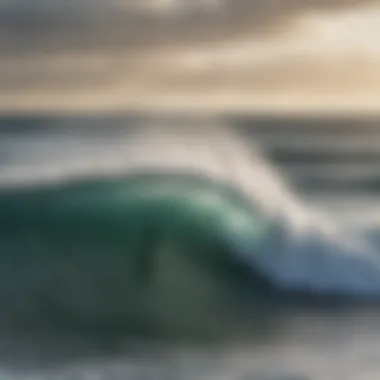

Surfers often encounter the term “swell,” which refers to the waves generated by distant storms. This is where things can get a bit more complex. A wave that's, say, four feet might feel different depending on the swell period—the time between waves. A short period swell might create choppy waters, making it difficult to ride, while a longer period swell often leads to more organized waves that are easier to surf.
"Wave height is more than just a number; it represents the soul of the surf day. Pay attention to it, and your session can transform from ordinary to extraordinary."
Understanding Wind Directions
Wind can drastically change surf conditions, which makes grasping wind direction essential. Each wind direction has its effects: offshore winds tend to create clean, well-formed waves, whereas onshore winds can create a confused, choppy sea.
Surfers should check the forecast for wind speed and direction before they head out. Winds blowing towards the shore can easily kill a good wave, while winds coming from the land can enhance the overall surf quality. A brief rule of thumb is: if the wind comes from land to sea (offshore), it could be a surf day to remember. Conversely, if it’s onshore, plan for a different type of water adventure.
Interpreting Tidal Patterns
Tides play a monumental role in surfing that often goes underappreciated. Tidal movements shift the structure of the ocean floor, which can either enhance or hinder a surf session. Understanding special tidal phases—high tide, low tide, and the transition periods—can provide savvy surfers with that extra edge.
For example, certain breaks work best at high tide, while others produce better waves at low tide. Each surf spot is unique, and knowing when to catch the tide can lead to a markedly superior experience. Observing local patterns over time can give valuable insight into which tides produce the best surf conditions for specific locations.
In summary, interpreting surf reports is not just about numbers and figures but is pivotal for fostering a resilient and enjoyable surfing experience. By grasping how to analyze wave height, understand wind directions, and interpret tidal patterns, surfers increase their chances of scoring better waves while simultaneously enjoying the ocean's nuances.
Local Conditions and Their Effects
Surfing isn’t just about the board and the waves; it’s a dance with nature, dictated by local conditions that can make or break your session. Understanding how these factors work is crucial for surfers looking to catch the best rides and avoid unexpected mishaps. From topography to climate, local conditions can significantly influence surfing quality, highlighting the need for thoughtful analysis before heading out.
Geographical Influences on Surfing
The lay of the land often sets the stage for your surf experience. Different coastal shapes can create entirely unique wave patterns. For instance, a beach with a sand bar can result in better, more organized waves compared to a rocky coastline. Additionally, tidal zones offer varying conditions, potentially producing great waves at one moment and washing them away the next.
To visualize this, consider the famed beaches of Hawaii. The reefs and underwater canyons create a vibrant surf scene, producing powerful swells that can challenge even seasoned surfers. In contrast, a sheltered cove may have smaller, mellow waves that are perfect for beginners. Here is what to keep in mind when assessing geographical influences:
- Type of coastline: Rocky vs. sandy beaches can significantly alter wave quality.
- Underwater structures: Reefs, sandbars, and canyons create different surfing environments.
- Wave direction: The angle of waves hitting the shore will change based on geographical features.
In essence, the geography doesn't just affect how the wave looks; it's also about how it behaves once it hits the shore.
Seasonal Changes in Surf Conditions
Surfing is a seasonal sport; waves and weather change throughout the year. Understanding how seasonal variations can affect surf conditions allows surfers to plan their outings more effectively. For example, winter often brings heavier swells to some locations as storm systems hit the coast. Conversely, summer might deliver gentler waves, attracting beginners eager to take their first steps on a board.
Let's break down the seasons:
- Winter: Big swells, more powerful waves, better for advanced surfers.
- Spring: Transition period; can offer ideal conditions as swells start to mellow.
- Summer: Ideal for beginners with smaller, more manageable waves.
- Fall: A wildcard, often offering favorable conditions as swell patterns stabilize.
Monitoring these changes isn’t just about finding the biggest wave; it’s about matching your skill level to the conditions. With the right awareness of local seasonal patterns, surfers can elevate their game and ensure a safe, enjoyable experience on the water.
Understanding your local conditions is half the battle in surfing. It’s not just about the forecast; it’s about recognizing how geography and seasons play into the waves you’ll ride.
The Role of Technology in Surf Forecasting
In the fast-paced world of surfing, technology is a key player in shaping the way surfers approach the waves. Gone are the days when surfers had to rely solely on word of mouth or outdated pamphlets to gauge conditions. Technology has transformed surf forecasting into a precise science. This section discusses how technological advancements have enriched our surfing experiences and what that means for surfers, from beginners to seasoned pros.
Advancements in Surf Metrics
In recent years, surf metrics have become increasingly sophisticated, allowing surfers to access a wealth of data at their fingertips. Various platforms utilize cutting-edge technologies to provide real-time information on wave patterns, swell direction, and even water temperature. For instance, buoy systems, placed strategically offshore, collect detailed information on wave height and frequency. These buoys relay data back to surf forecasting websites, often updating every few minutes.
Surfers can now check conditions simply by glancing at their phones. This immediate access to accurate surf metrics allows for better decision-making regarding when and where to surf. The shift from anecdotal reports to data-driven analysis has given surfers the confidence to tackle new spots based on factual information. Notably, peer-reviewed studies in oceanography and surf science have enhanced our understanding of surf conditions, making metrics not just guesses but educated predictions based on sound research.
Utilization of Data Analytics
Data analytics plays a critical role in surf forecasting, enabling the parsing of vast amounts of information to uncover actionable insights for surfers. Through the processing of historical data, surf forecasting platforms can identify patterns and trends that reveal what conditions are likely in the future. For example, machine learning algorithms can analyze years' worth of data to forecast swell conditions for a specific beach.
"Utilizing data analytics helps surfers make informed choices, transforming mere guesswork into strategic planning."
By combining environmental data with local observations, surfers now understand how factors such as wind, tide, and geography interact to create ideal surf conditions. Surf forecasting applications have embraced these methods, presenting users with easy-to-read visualizations that demystify complex data. This not only caters to the tech-savvy generation but also engages traditional surfers who may not be familiar with statistical methods.
In summary, technology is revolutionizing how surf reports are generated and interpreted. With advancements in surf metrics and the use of data analytics, surfers can access reliable information that profoundly influences their surf strategy. As technology continues to streamline these processes, surfers can expect even more accurate forecasts and a deeper understanding of their aquatic playground.
Crafting a Surfing Strategy
Surfing is not merely about riding the waves; it’s about crafting a strategy that aligns with your personal goals and local conditions. A sound surfing strategy is especially crucial for both novices and seasoned surfers looking to maximize their experience. In a sport where conditions can change in the blink of an eye, having a clear plan helps surfers exploit the best available waves while minimizing challenges. This section explores two vital components of an effective surfing strategy: choosing the right location and timing your surf sessions, leading to more rewarding experiences on the water.
Choosing the Right Location
Selecting the right surf spot can be the difference between a lackluster day and an epic session. Location isn't just about personal preference; it intertwines with various factors such as wave quality, crowd size, and local regulations.
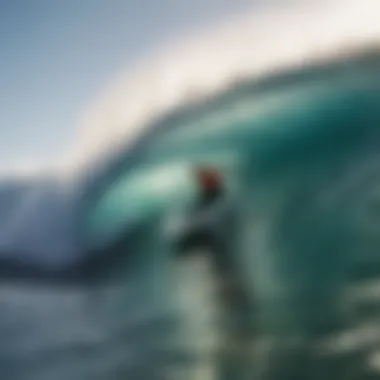

- Understand the Break: Each surf break possesses its unique characteristics. Figure out whether it’s a reef break, beach break, or point break. For instance, knowing that a reef break like Banzai Pipeline in Hawaii is best at high tide can shape when you hit the water. Delving into surf maps and local guides can give you insights that aren’t easily gleaned from generic surf reports.
- Crowd Size and Skill Levels: Popular spots draw many surfers, often making it challenging to find a wave. Consider venturing to less-known locations or trying to surf during off-peak hours. Sometimes, a hidden gem like a rocky inlet could provide less crowded and exhilarating waves that cater to your skill level.
- Facilities and Safety: Consider having amenities nearby, like showers or food stalls. Safety is paramount; thus, understanding local wildlife, currents, and sandy bottoms is crucial.
All these factors coalesce to form an informed decision about where to surf. It’s best to tune into Facebook groups or local forums to gauge the conditions and emotions of fellow surfers. Participating in the community can also open up discussions about secret spots that may not appear in mainstream guides.
Timing Your Surf Session
Timing is a delicate dance when it comes to surfing. Surf conditions are ever-changing, influenced by tides, wind, and even the sun's position in the sky. Here’s how to refine your timing:
- Wave Patterns: Understanding when waves are most likely to be favorable is key. Many surfers swear by the saying, "The early bird catches the wave." Morning sessions often bring glassy conditions before the winds kick up later in the day. Check local tide charts and sync them with surf reports.
- Local Weather Trends: Conditions can change dramatically within the same day. Storm fronts or shifts in wind direction can drastically alter surf quality. Stay tuned to weather forecasts for your area. Apps like Windy or Surfline can provide real-time updates on changing conditions.
- Seasonal Considerations: Different seasons present distinct swells. For instance, some locations may see short, powerful winter swells, while others thrive during the gentler summer months. Understanding these seasonal patterns can set you up for sessions that suit your skill level and style.
"Surfing is not just about the destination; it’s about maximizing what each session has to offer."
When these elements come together, you orchestrate an experience that caters not only to your skills but also to the ever-changing dance of the waves. Crafting a thoughtful surfing strategy can elevate your sessions, ensuring that each ride is better than the last while also respecting the local environment and surf culture.
Sustainability Considerations in Surf Reporting
Sustainability is a term that’s become more vital, not just in the realm of environmental advocacy but also in the actions we take while surfing. As surfers, we are intimately connected to the ocean. It’s not just a pastime; it’s an inseparable part of our lifestyle and culture. As such, our enjoyment of the waves comes into play with the health of our marine environments. Recognizing the sustainability considerations in surf reporting can ultimately enhance our surfing experiences while fostering a responsible relationship with nature.
Environmental Factors Affecting Surf Conditions
Numerous environmental factors influence the quality of surf conditions, each bearing significance for both the waves and the ecosystems. These factors encompass:
- Coastal Erosion: This affects how waves break and, ultimately, the surfable conditions we encounter. Coastal erosion may lead to loss of beach features:**, resulting in less favorable waves.
- Water Quality: Pollution can significantly affect not just our surf experience but also marine life. If the water quality is low, it may pose health risks for surfers.
- Temperature Fluctuations: With changing climates, shifts in water temperatures can deter marine creatures, which in turn can affect wave patterns and formations.
Understanding how these environmental elements are monitored and reported is precisely where sustainability steps in. Through updated surf reports, surfers can make informed decisions about when and where to surf, ideally enabling them to avoid areas that are not ecologically sustainable.
"Every wave we ride should be treated kindly, with care for the ocean that gives it life."
Promoting Eco-Conscious Surfing
Surfing doesn't exist in a vacuum; our enjoyment of the sport carries weight in terms of its ecological impact. Promoting eco-conscious surfing seeks to cultivate a community that not only appreciates wave riding but also respects the natural environment. Here are ways to engage in eco-friendly practices while surfing:
- Utilize Eco-Friendly Gear: Opt for boards made of sustainable materials, like recycled foam or wood. Brands like Firewire and Greenlight are exemplary in this regard, providing options that lessen our ecological footprint.
- Participate in Beach Cleanups: Consider joining local surf clubs in organizing or participating in beach cleanups. This hands-on approach not only reduces debris but fosters community.
- Share Sustainable Practices: Use social media platforms like Facebook and Reddit to discuss eco-conscious surfing tips and local sustainability concerns. Knowledge is power, and sharing insights can lead to broader awareness and understanding among surfers.
In sum, sustainability considerations within surf reporting are increasingly pivotal. They lead not only to improved practices among surfers but also to a healthier ocean ecosystem. By making informed choices and rooting for eco-conscious surfing, we contribute to the preservation of the very waters that bring us joy.
Building a Community Around Surf Reports
Creating a community around surf reports isn’t just about sharing information; it’s about building relationships and fostering a sense of belonging among surfers. When surfers engage with each other, they exchange not only the latest surf conditions but also tips, experiences, and support. This network can enhance the surfing experience, making it richer and more enjoyable.
Engaging with Local Surfers
Local surfers possess a wealth of knowledge about their home breaks. Engaging with them can lead to insights that are often missed in online reports. Here's why you should get to know local surfers:
- Local Knowledge: Every spot has its nuances. A local surfer might know the best times to catch waves, hidden breaks, and rip currents that can affect safety.
- Community Events: Local surf competitions and beach cleanups offer a chance to connect with others who share your passion. These events not only help you meet other surfers, but they also strengthen the community.
- Mentorship Opportunities: If you’re a newbie or looking to perfect your technique, local surfers can provide guidance and mentorship. Their feedback can be invaluable, turning a good session into a great one.
Ways to engage with them include visiting local surf shops, participating in community discussions on platforms like Reddit, and checking Facebook groups dedicated to surfing in your area. These interactions can form the backbone of a supportive surfing community.
Sharing Personal Surf Experiences
Every surfer has a story that shapes their unique relationship with the ocean. Sharing personal experiences not only cultivates camaraderie but also enriches the collective knowledge base of the surfing community. Here are some benefits:
- Learning from Each Other: Stories about the conditions on specific days or the lessons learned from a challenging surf session can offer valuable takeaways for others.
- Inspiration: Hearing about a fellow surfer’s journey can motivate others to push their limits or try new techniques. A tale of triumph over challenging conditions can ignite a spark in someone who’s been hesitant.
- Building Bonds: Personal stories can create deeper connections among surfers. As they open up about their fears, breakthroughs, and memorable sessions, they create an atmosphere of trust and support.
Consider jotting down your surf stories in a blog or contributing to online forums dedicated to surfing. Also, utilize platforms like Facebook to join groups where you can share your experiences and read about others’. The shared narrative strengthens community ties and enriches everyone’s surfing journey.
Community plays a vital role in enhancing the surfing experience—by learning from each other and sharing stories, surfers can navigate the waves of life together.
In summary, building a community around surf reports transcends mere data sharing; it fosters a thriving network of individuals who support and learn from one another. Engaging with local surfers and sharing personal experiences are critical components of this journey. As surfers cultivate these relationships, they not only improve their skills but also develop a profound appreciation for the sport and the environment.
Future Trends in Surf Reporting
As surfing continues to evolve, so does the way enthusiasts access information vital to their experiences on the water. Understanding future trends in surf reporting can significantly enhance a surfer's ability to make informed decisions. By keeping an eye on new developments, surfers not only stay ahead of the game but also adapt to changes that can directly affect their sessions. An awareness of these trends can lead to safer and more enjoyable outings while fostering a stronger connection with the surf community.
Emerging Technologies
In recent years, technology has transformed numerous industries, and surfing is no exception. The advent of high-tech tools is helping surfers to better predict conditions. Drones, for instance, are becoming more commonplace for capturing live, real-time surf conditions. These machines fly high above the waves, giving a bird's-eye view that can reveal everything from swell height to crowd levels. As companies innovate, we may see even more advancements, such as sensors mounted in the ocean that can measure wave energy and convey that data straight to surfers' devices.
One of the most notable emerging technologies is the use of Artificial Intelligence (AI). Developers are creating AI-driven algorithms that can analyze historical surf data and current environmental conditions, generating precisely calculated forecasts. Such insights allow surfers to pin down the best times and locations, essentially predicting the unpredictable nature of waves. This fusion of technology and surfing cultivates smarter surf sessions and propels the sport even further into the modern age.
"Technology in surf reporting is like a great swell, it rises with unseen force, surprising you with its potential."
Changes in Data Collection Methods
The way data is collected for surf reporting has seen significant changes, making the process more accurate and user-friendly. Traditionally, surfers relied on local observations and guesswork, often leading to misconceptions about conditions. Now, information is gathered through various methods including satellite imagery, buoy data, and oceanographic sensors. These tools provide precise metrics about wind speed, wave direction, and tidal fluctuations.
Moreover, crowdsourcing has gained traction in recent years. Local surfers, equipped with mobile apps, can share real-time data about current conditions. Sharing insights can create a community-driven approach enabling surfers to contribute to the collective knowledge base, ensuring that everyone can ride the best waves.
In summary, staying informed of future trends in surf reporting not only enhances personal surfing experiences but enables holistic understanding among surfers everywhere. As technology continues to advance and methods of data collection improve, surfers will find themselves more empowered than ever to navigate the waves successfully.






